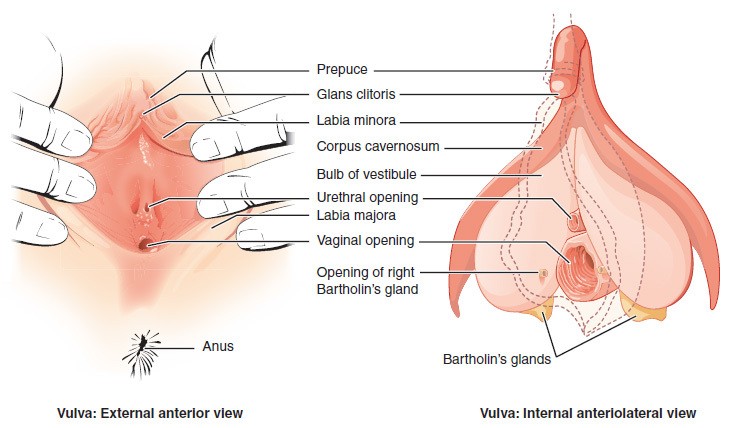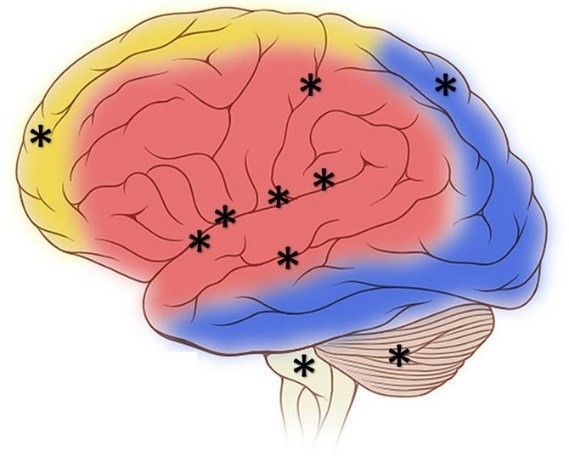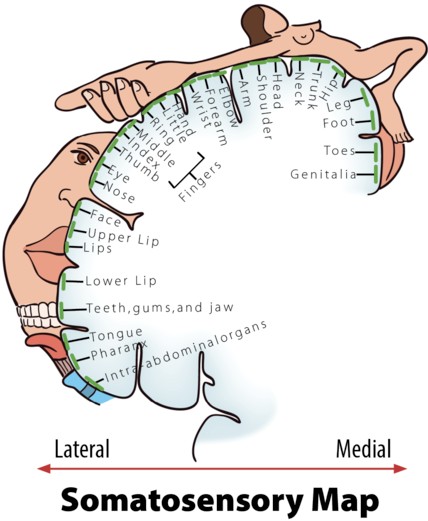The Anatomy of Pleasure and Reproduction
Sexual anatomy is typically discussed only in terms of reproduction (see e.g., King, 2015). However, reproduction is only a (small) part of what drives us sexually (Lucas & Fox, 2018). Full discussions of sexual anatomy also include the concept of pleasure. Thus, we will explore the sexual anatomies of females (see Figures 1a and 1b) and males (see Figure 2) in terms of their capabilities for both reproduction and pleasure.
Female Anatomy
Many people find female sexual anatomy curious, confusing, and mysterious. This may be because so much of it is internal (inside the body), or because—historically—women have been expected to be modest and secretive regarding their bodies.

Figure 1a: The Female’s External Sex Organs. [Image: Open Stax College, https://goo.gl/Hj59kX, CC BY 3.0, https://goo.gl/Dmg4Uu]
Perhaps the most visible structure of female sexual anatomy is the vulva. The primary functions of the vulva are pleasure and protection. The vulva is composed of the female’s externalsex organs (see Figure 1a). It includes many parts:
the labia majora—the “large lips” enclosing and protecting the female’s internal sex organs;
the labia minora—the“small lips” surrounding and defining the openings of the vagina and urethra; the minor and major vestibular glands (VGs).
The minor VGs—also called Skene’s glands (not pictured), are on the wall of the vagina and are associated with female ejaculation, and mythologically associated with the G-Spot (Kilchevsky et al., 2012; Wickman, 2017). The major VGs—also called Bartholin’s glands—are located just to the left and right of the vagina and produce lubrication to aid in sexual intercourse. Most females—especially postmenopausal females—at some time in their lives report inadequate lubrication, which, in turn, leads to discomfort or pain during sexual intercourse (Nappi & Lachowsky, 2009). Extending foreplay and using commercial water-, silicone-, or oil-based personal lubricants are simple solutions to this common problem.
The clitoris and vagina are considered parts of the vulva as well as internal sex organs (see Figure 1b). They are the most talked about organs in relation to their capacities for female pleasure (e.g., Jannini et al., 2012). Most of the clitoris, which is composed of 18 parts with an average overall excited length of about four inches, cannot be seen (Ginger & Yang, 2011; O’Connell et al., 2005). The visible parts—the glans and prepuce—are located above the urethra and join the labia minora at its pinnacle. The clitoris is highly sensitive, composed of more than 8,000 sensory-nerve endings, and is associated with initiating orgasms; 90% of females can orgasm by clitoral stimulation alone (O’Connell et al., 2005; Thompson, 2016).
The vagina, also called the “birth canal,” is a muscular canal that spans from the cervix to the introitus. It has an average overall excited length of about four and a half inches (Masters & Johnson, 1966) and has two parts: First, there is the inner two-thirds (posterior wall)—formed during the first trimester of pregnancy. Second, there is the outer one-third of the vagina (anterior wall). It is formed during the second trimester of pregnancy and is generally more sensitive than the inner portion, but dramatically less sensitive than the clitoris (Hines, 2001). Only between 10% and 30% of females achieve orgasms by vaginal stimulation alone (Thompson, 2016). At each end of the vagina are the cervix (the lower portion of the uterus) and the introitus (the vaginal opening to the outside of the body). The vagina acts as a transport mechanism for sperm cells coming in, and menstrual fluid and babies going out. A healthy vagina has a pH level of about four, which is acidic. When the pH level changes, often due to normal circumstances (e.g., menstruation, using tampons, sexual intercourse), it facilitates the reproduction of microorganisms that often cause vaginal odor and pain (Anderson, Klink & Cohrssen, 2004). This potential problem can be solved with over-the-counter vaginal gels or oral probiotics to maintain normal vaginal pH levels (Tachedjiana et al., in press).

Figure 1b: The Female’s Internal Sex Organs. [Image: unknown, https://goo.gl/5GMbCr, CC BY-SA 3.0, https://goo.gl/jidmcs]
The primary functions of the internal sex organs of the female are to store, transport, and keep ovum cells (eggs) healthy; and produce hormones (see Figure 1b). These organs include:
the uterus (or womb)—where human development occurs until birth;
the ovaries—the glands that house the ova (eggs; about two million; Faddy et al., 1992) and produce progesterone, estrogen, and small amounts of testosterone; the fallopian tubes—where fertilization is most likely to occur. These tubes allow for ovulation (about every 28 days), which is when ova travel from the ovaries to the uterus. If fertilization does not occur, menstruation begins. Menstruation, also known as a “period,” is the discharge of ova along with the lining of the uterus through the vagina, usually taking several days to complete.
Male Anatomy
The most prominent external sex organ for the male is the penis. The penis’s main functions are initiating orgasm, and transporting semen and urine from the body. On average, a flaccid penis is about three and a half inches in length, whereas an erect penis is about five inches (Veale et al., 2015; Wessells, Lue & McAninch, 1996).

Figure 2: The Male’s Internal and External Sex Organs. [Image: unknown, https://goo.gl/9kUDCN, CC BY-SA 3.0, https://goo.gl/jidmcs]
If you want to know the length of a particular male’s erect penis, you’ll have to actually see it—because there are no reliable correlations between the length of an erect penis and (a) the length of a flaccid penis, (b) the lengths of other body parts—including feet, hands, forearms, and overall height—or (c) race and ethnicity (Shah & Christopher, 2002; Siminoski & Bain, 1993; Veale et al., 2015; Wessells, Lue & McAninch, 1996). The penis has three parts: the root, shaft, and glans. Foreskin covers the glans, or head of the penis, except in circumcised males. The glans penis is highly sensitive, composed of more than 4,000 sensory-nerve endings, and associated with initiating orgasms (Halata, 1997). Lastly, it has the urethral opening that allows semen and urine to exit the body.
In addition to the penis, there are other male external sex organs that have two primary functions: producing hormones and sperm cells. The scrotum is the sac of skin behind and below the penis containing the testicles. The testicles (or testes) are the glands that produce testosterone, progesterone, small amounts of estrogen, and sperm cells.
Many people are surprised to learn that males also have internal sex organs. The primary functions of male internal sex organs are transporting sperm cells, keeping sperm cells healthy, and producing semen—the fluid in which sperm cells are transported. The male’s internal sex organs include:
the epididymis, which is a twisted duct that matures, stores, and transports sperm cells into the vas deferens;
the vas deferens—a muscular tube that transports mature sperm to the urethra, except in males who have had a vasectomy; the seminal vesicles—glands that provide energy for sperm cells to move. This energy is in the form of sugar (fructose) and it composes about 75% of the semen. Sperm cells only compose about 1% of the semen (Owen & Katz, 2005);
the prostate gland, which provides additional fluid to the semen that nourishes the sperm cells; and the Cowper’s glands, which produce a fluid that lubricates the urethra and neutralizes any acidity due to urine; the urethra—the tube that carries urine and semen outside of the body.
Sex on the Brain
At first glance—or touch for that matter—the clitoris and penis are the parts of our anatomies that seem to bring the most pleasure. However, these two organs pale in comparison to our central nervous system’s capacity for pleasure. Extensive regions of the brain and brainstem are activated when a person experiences pleasure, including: the insula, temporal cortex, limbic system, nucleus accumbens, basal ganglia, superior parietal cortex, dorsolateral prefrontal cortex, and cerebellum (see Figure 3, Ortigue et al., 2007). Neuroimaging techniques show that these regions of the brain are active when patients have spontaneous orgasms involving no direct stimulation of the skin (e.g., Fadul et al., 2005) and when experimental participants self-stimulate erogenous zones (e.g., Komisaruk et al., 2011). Erogenous zones are sensitive areas of skin that are connected, via the nervous system, to the somatosensory cortex in the brain.

Figure 3: Some of the many regions of the brain and brainstem activated during pleasure experiences. [Image: Frank Gaillard, https://goo.gl/yCKuQ2, CC-BY-SA 3.0. Identifying marks added]

Figure 4: Erogenous Zones Mapped on the Somatosensory Cortex.
The somatosensory cortex (SC) is the part of the brain primarily responsible for processing sensory information from the skin. The more sensitive an area of your skin is (e.g., your lips), the larger the corresponding area of the SC will be; the less sensitive an area of your skin is (e.g., your trunk), the smaller the corresponding area of the SC will be (see Figure 4, Penfield & Boldrey, 1937). When a sensitive area of a person’s body is touched, it is typically interpreted by the brain in one of three ways: “That tickles!” “That hurts!” or, “That…you need to do again!” Thus, the more sensitive areas of our bodies have greater potential to evoke pleasure. A study by Nummenmaa and his colleagues (2016) used a unique method to test this hypothesis. The Nummenmaa research team showed experimental participants images of same- and opposite-sex bodies.
They then asked the participants to color the regions of the body that, when touched, they or members of the opposite sex would experience as sexually arousing while masturbating or having sex with a partner. Nummenmaa found the expected “hotspot” erogenous zones around the external sex organs, breasts, and anus, but also reported areas of the skin beyond these hotspots: “[T]actile stimulation of practically all bodily regions trigger sexual arousal….” Moreover, he concluded, “[H]aving sex with a partner…”—beyond the hotspots—“…reflects the role of touching in the maintenance of…pair bonds.”

